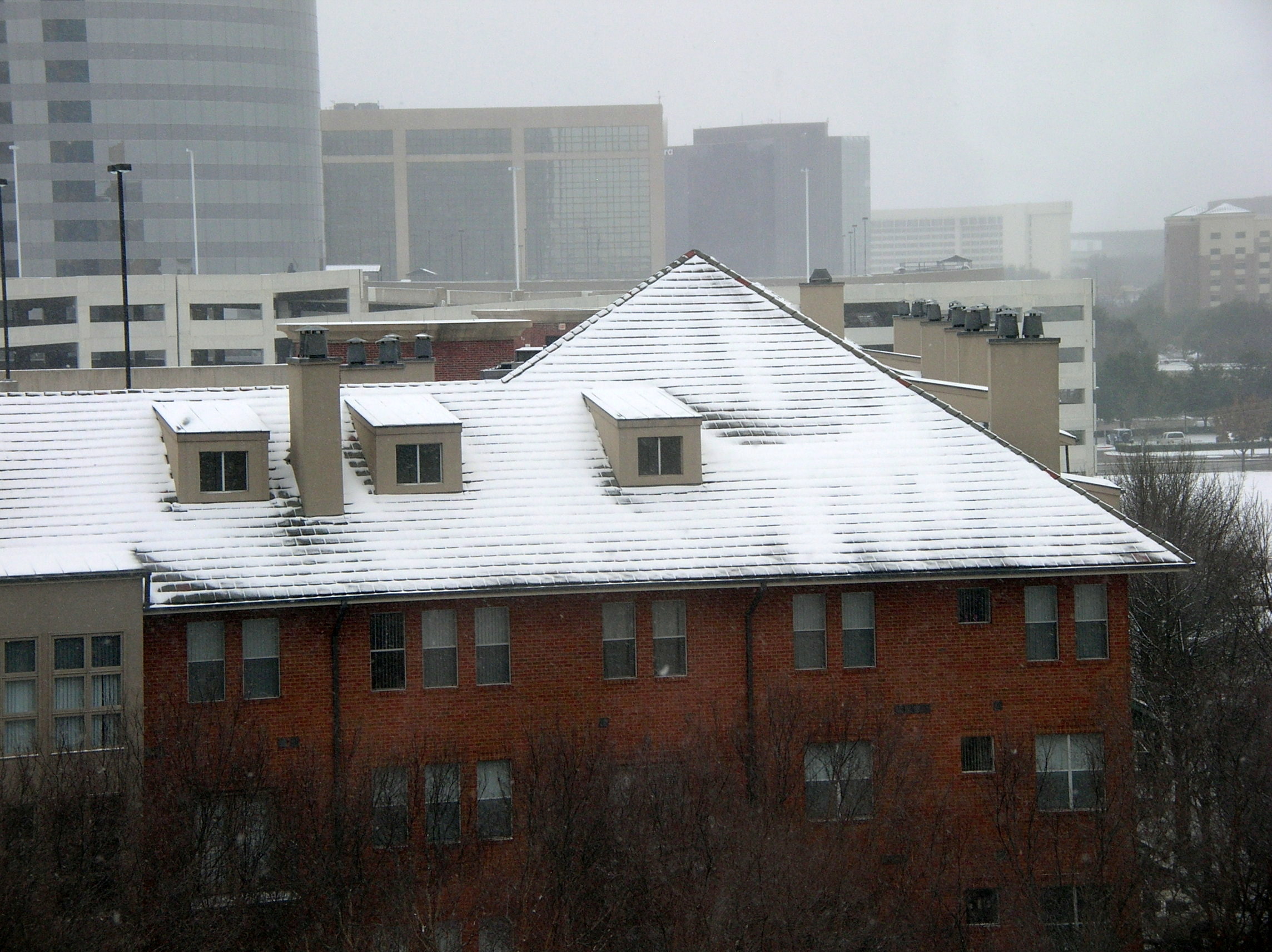
Weight of Snow • Snow Density Chart
By Roof Online Staff • Last updated November 19, 2022
Snow Weight Calculator
Table of Contents
- Introduction
- What Determines Snow Density?
- Why You Should Know How Heavy Snow Is
- About Our Snow Weight Table
- Table: Weight of Snow for Various Snow Types
- Related Pages
- Snow Weight References

Introduction
The weight of snow is a vital piece of information. Whole sections of the building code are based on knowing how much additional weight a structure will need to support due to the typical snow loads in a given region.
There is no foolproof rule of thumb regarding snow weight. To estimate snow weight accurately, you need to know the conditions under which the snow formed, and what conditions the snow has experienced since it fell.
Snow can vary in weight from a little over a pound to as much as 30 pounds per cubic foot. Fresh, dry, fluffy snow might only weigh about four pounds per cubic foot. Snow that has been sitting for a few days under normal conditions will usually weigh around 15 pounds per cubic foot.
But there are variables, and they make a big difference.
What Determines Snow Density?
Snow density is a function of temperature, wind exposure, time, and the depth of the snow.
Snow density increases over time as the snow experiences more changes in temperature and wind. Warmer temperatures lead to higher (and heavier) moisture content, and this moisture may re-freeze into ice when the temperature drops.
Wind abrades snow particles, making them smaller and rounding off their edges so they have a more uniform shape. This allows them to fit together more tightly, compacting the snow, so snow will be heavier after being exposed to wind.
Snow will also be compacted by its own weight, so the deeper the snow, the denser the lower portion of the snowfall will be, and the heavier the snow will be on average per unit of volume.

Why You Should Know How Heavy Snow Is
The weight of snow can be an important piece of information for a number of reasons.
For instance, a typical scoop of snow with a snow shovel is about 1.5 cubic feet, so there’s a good chance you’re out there lifting more than 30 lbs. over and over again while you’re clearing your driveway. It’s good to know the weight of snow.
Roof collapse due to the weight of snow exceeding the load-bearing capacity of a roof structure is a primary concern of people looking up the weight of snow. For in-depth information on how the weight of snow may affect your roof, please see the links available on our page Snow Issues and Roofs.
Removing Snow from a Roof
Anyone planning to remove snow from a roof should first have a look at “Falls and Other Hazards to Workers Removing Snow from Rooftops and Other Elevated Surfaces“. This safety guide was put together by OSHA and we recommend that you take a few minutes to read it.
If you’re considering trying to remove snow from your roof yourself, please see these snow rakes (on Amazon). They are designed to allow snow to be removed while you are standing on the ground. Using a ladder in the snow can be extremely dangerous.
You should never remove all of the snow from one side of a roof before moving on to the other side of the roof. This can be incredibly dangerous, especially with heavy snow loads.
When removing snow from a roof, you should remove a little from each side, and then a little more from each side, and so on.
Asymmetrical snow removal creates a load imbalance on your roof that can overstress and possibly break the framing connections in your roof structure. Read more here.
About Our Snow Weight Table
The following table provides the typical weight of snow (or snow density) for snow that has formed and accumulated under various conditions.
Weights for air, ice, and liquid water are also included, as these are the three principal components of snow. The weight of snow is a product of the percentage of each of these things within a given volume of snow. (We do not account for dirt, debris, etc. when calculating the weight of snow.)
Snow Depth and Snow Weight
Important Note: Be aware that the average density of snow will increase as the snow gets deeper, as the weight of the additional snow above will compact the snow closer to the bottom. The deeper the snow, the heavier the average weight of the snow will be per unit of volume.
As an example, if snow that is 6 inches deep has an average density of 1 pound per square foot per inch of depth, the same type of snow at 4 feet deep will typically weigh 1.5 pounds per inch per square foot.
In other words, increasing the depth of the snow from from 6 inches deep to 4 feet deep increases the average snow density by about 50%.
Here’s another example: According to NASA, “a cubic meter of freshly-fallen snow has an average mass of about 50 kilograms. Snow that has been compacted by its own weight at a depth of 3 meters can have 200 kilograms in the same volume.”
That is an increase in snow density of 300% for the bottom meter of 3-meter-deep snow.
Keep this in mind when using the table below.
Table: Weight of Snow for Various Snow Types
All weights given in this table are approximations and real world values will vary.
| Weight of Snow | ||||||
|---|---|---|---|---|---|---|
| Type of Snow | Lbs per Inch of Depth per Square Foot (Average) |
Lbs per Cubic Foot (lb/ft³) (Average) |
Lbs per Cubic Foot (lb/ft³) (Range) |
Grams per Cubic Centimeter (g/cm³) (Range) |
Kg per Cubic Meter (kg/m³) (Average) |
Kg per Centimeter of Depth per Square Meter (Average) |
| Air (Average weight of air at sea level at freezing.) |
0.007 lbs | 0.08 lb/ft³ |
0.08 lb/ft³ |
0.0013 g/cm³ |
1.29 kg/m³ |
0.0129 kg |
| Wild Snow (Light, very dry new snow. Snow immediately after falling, in extremely cold temperatures, with no wind.) |
0.1 lbs | 1.25 lb/ft³ |
0.62 – 1.87 lb/ft³ |
0.01 – 0.03 g/cm³ |
20 kg/m³ |
0.20 kg |
| Ordinary New Snow (Snow immediately after falling, in below-freezing temperatures, with no wind; fresh, uncompacted snow that has a high volume of trapped air.) |
0.3 lbs | 3.59 lb/ft³ |
3.12 – 4.06 lb/ft³ |
0.05 – 0.065 g/cm³ |
57.5 kg/m³ |
0.58 kg |
| New Snow Slightly Compacted by Wind (Snow immediately after falling, in below-freezing temperatures, with some wind exposure. Less trapped air.) |
0.37 lbs | 4.46 lb/ft³ |
3.93 – 4.99 lb/ft³ |
0.063 – 0.08 g/cm³ |
71.5 kg/m³ |
0.715 kg |
| Settling Snow (Snow less than a day old that is starting to experience some wind and temperature variation.) |
0.68 lbs | 8.12 lb/ft³ |
4.37 – 11.86 lb/ft³ |
0.07 – 0.19 g/cm³ |
130 kg/m³ |
1.30 kg |
| Damp New Snow (Snow immediately after falling, in slightly above-freezing temperatures, with little wind exposure.) |
0.78 lbs | 9.37 lb/ft³ |
6.24 – 12.49 lb/ft³ |
0.1 – 0.2 g/cm³ |
150 kg/m³ |
1.50 kg |
| Sugar Snow (Snow with large grains formed when water vapor freezes onto existing snow crystals.) |
1.04 lbs | 12.49 lb/ft³ |
6.24 – 18.73 lb/ft³ |
0.1 – 0.3 g/cm³ |
200 kg/m³ |
2 kg |
| Settled Snow (Typical after more than one day in place. Snow that has experienced some temperature and wind variation.) |
1.3 lbs | 15.61 lb/ft³ |
12.49 – 18.73 lb/ft³ |
0.2 – 0.3 g/cm³ |
250 kg/m³ |
2.5 kg |
| Average Wind-Toughened Snow (Compacted snow after wind exposure in below-freezing temperatures.) |
1.46 lbs | 17.48 lb/ft³ |
17.48 lb/ft³ |
0.28 g/cm³ |
280 kg/m³ |
2.8 kg |
| Wet Snow (Dense, sticky snow in relatively warm temperatures with little wind. Good snow for making snowballs.) |
1.75 lbs | 21 lb/ft³ |
17 – 25 lb/ft³ |
0.27 – 0.40 g/cm³ |
335 kg/m³ |
3.35 kg |
| Wind-Packed Snow (Hard Wind Slab. Compacted snow after prolonged and heavy wind exposure.) |
1.98 lbs | 23.73 lb/ft³ |
21.85 – 25.6 lb/ft³ |
0.35 – 0.41 g/cm³ |
380 kg/m³ |
3.8 kg |
| New Firn Snow (Firn is granular, icy, highly-compacted, pre-glacial snow. Some ice present.) |
2.47 lbs | 29.66 lb/ft³ |
24.97 – 34.34 lb/ft³ |
0.40 – 0.55 g/cm³ |
475 kg/m³ |
4.75 kg |
| Advanced Firn Snow | 3.12 lbs | 37.46 lb/ft³ |
34.34 – 40.58 lb/ft³ |
0.55 – 0.65 g/cm³ |
600 kg/m³ |
6 kg |
| Thawing Firn Snow | 3.38 lbs | 40.58 lb/ft³ |
37.46 – 43.70 lb/ft³ |
0.6 – 0.7 g/cm³ |
650 kg/m³ |
6.5 kg |
| Slush (Advanced melting snow; snow/water mix.) |
3.75 lbs | 45 lb/ft³ |
35 – 55 lb/ft³ |
0.56 – 0.88 g/cm³ |
720 kg/m³ |
7.2 kg |
| Ice with Air Bubbles (Cloudy ice.) |
4.5 lbs | 54 lb/ft³ |
51.19 – 56.81 lb/ft³ |
0.82 – 0.91 g/cm³ |
873 kg/m³ |
8.73 kg |
| Pure Ice (Ice with no entrapped air.) |
4.77 lbs | 57.25 lb/ft³ |
57.25 lb/ft³ |
0.92 g/cm³ |
917 kg/m³ |
9.17 kg |
| Water (At sea level just above freezing.) |
5.2 lbs | 62.43 lb/ft³ |
62.43 lb/ft³ |
1 g/cm³ |
1000 kg/m³ |
10 kg |
Related Pages
- Building Codes and Roofs
- How to Find the Area of a Sloped Roof
- Snow Issues and Roofs
- Weight of Roofing Materials
- Weight of Water per Inch for Ponding Water
Snow Weight References
- 2018 International Building Code, Chapter 16 Structural Design, Section 1608 Snow Loads; International Code Council; 2017
- Snow, National Snow and Ice Data Center
- Handbook of Snow: Principles, Processes, Management & Use; Gray and Male; 1981
- The International Classification for Seasonal Snow on the Ground; International Association of Cryospheric Sciences; 2009
- Snow Structure and Ski Fields, being an Account of Snow and Ice Forms met with in Nature and a study on Avalanches and Snowcraft; G. Seligman; With an Appendix on Alpine Weather; C. K. M. Douglas; 1936